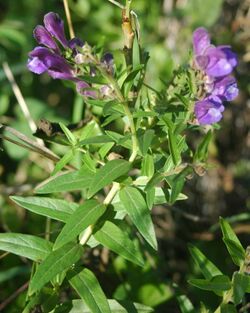Biology:Scutellaria baicalensis
| Scutellaria baicalensis | |
|---|---|

| |
| Scientific classification Error creating thumbnail: Unable to save thumbnail to destination
| |
| Kingdom: | Plantae |
| Clade: | Tracheophytes |
| Clade: | Angiosperms |
| Clade: | Eudicots |
| Clade: | Asterids |
| Order: | Lamiales |
| Family: | Lamiaceae |
| Genus: | Scutellaria |
| Species: | S. baicalensis
|
| Binomial name | |
| Scutellaria baicalensis Georgi[1]
| |
| Synonyms | |
|
Scutellaria macrantha Fisch.[1] | |
Scutellaria baicalensis, with the common name Baikal skullcap or Chinese skullcap, is a species of flowering plant in the family Lamiaceae.
Distribution
The plant is native to China , Korea, Mongolia, and Russia in the Russian Far East and Siberia.[1]
Traditional Chinese medicine
It is one of the 50 fundamental herbs used in traditional Chinese medicine, where it has the name huángqín (Chinese: 黄芩).[2] As a Chinese traditional medicine, huang qin usually refers to the dried root of S. baicalensis Georgi, S. viscidula Bge., S. amoena C.H. Wright, and S. ikoninkovii Ju.
Phytochemicals
Several phytochemicals have been isolated from the root; baicalein, baicalin, wogonin, norwogonin, oroxylin A[3] and β-sitosterol are the major ones.[4]
Names
As the term 'skullcap' is applied to over 200 plant varieties, the scientific name is used. Sometimes, Scutellaria lateriflora (North American skullcap) is mistaken for S. baicalensis.
Adverse effects
There have been several reports and small case series of acute liver injury with jaundice arising 1 to 3 months after starting herbal or dietary supplements containing S. baicalensis.[5]
See also
- Piper methysticum (kava), another anxiolytic GABAergic plant
- Valeriana officinalis (valerian), a sedative GABAergic plant
References
- ↑ 1.0 1.1 1.2 {{citation | mode = cs1 | title = Scutellaria baicalensis | work = Germplasm Resources Information Network (GRIN) | url = | publisher = [[Organization:Agricultural Research ServAgricultural Research Service (ARS), United States Department of Agriculture (USDA) | access-date = 2008-02-19 }}
- ↑ Zhang XW; Li WF; Li WW; Ren KH; Fan CM; Chen YY; Shen YL (2011). "Protective effects of the aqueous extract of Scutellaria baicalensis against acrolein-induced oxidative stress in cultured human umbilical vein endothelial cells". Pharm Biol 49 (3): 256–261. doi:10.3109/13880209.2010.501803. PMID 20979538.
- ↑ Isolation and purification of baicalein, wogonin and oroxylin A from the medicinal plant Scutellaria baicalensis by high-speed counter-current chromatography. Hua-Bin Li and Feng Chen, Journal of Chromatography A, 13 May 2005, Volume 1074, Issues 1–2, pages 107–110, doi:10.1016/j.chroma.2005.03.088
- ↑ "[Determination of flavone for Scutellaria baicalensis from different areas by HPLC]" (in zh). Zhongguo Zhong Yao Za Zhi 27 (3): 166–70. 2002. PMID 12774393.
- ↑ LiverTox: Clinical and Research Information on Drug-Induced Liver Injury. 2012. PMID 31644066. https://www.ncbi.nlm.nih.gov/books/NBK548757/. Retrieved 27 June 2022.
External links
- Scutellaria baicalensis List of Chemicals (Dr. Duke's Databases)
- Scutellaria baicalensis (Plants for a Future)
Wikidata ☰ Q803769 entry
 |

